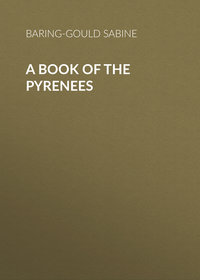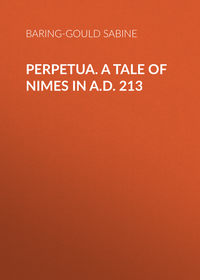 полная версия
полная версияThe Lives of the Saints, Volume II (of 16): February
Such a practical exhibition of Christian love could not fail to exercise a gradual influence even over the rough pirates of the North, which was increased by the many miracles he wrought. But he was not one to seek distinction of this kind. "One miracle," he once said to a friend, "I would if worthy, ask the Lord to grant me; and that is, that by His grace, He would make me a good man."
He employed his last days in arranging the affairs of his diocese, and calmly expired on the 3rd of February, a. d. 865.
Relics. At Corbie is preserved an arm of the Saint.
February 4
S. Veronica, Matr. at Rome, 1st cent.
S. Phileas, B. of Thmuis, S. Philoromus and Others, MM. at Alexandria, a. d. 304.
S. Abraham, M. B. of Arbela, in Persia, a. d. 348.
S. Gelasius, C. at Piacenza, beginning of 5th cent.
S. Isidore of Pelusium, P. Monk in Egypt, 5th cent.
S. Aventine, H. of Troyes, a. d. 538.
S. Aventine, B. of Chateaudun, 6th cent.
S. Theophilus the Penitent, C. at Adana in Cilicia, circ. a. d. 538.
S. Liephard, B. M. at Honcourt, circ. a. d. 640.
S. Modan, Ab. in Scotland, 7th cent.
S. Ulgis, Ab. B. at Lobies, 8th cent.
B. Hrabanus Maurus, Abp. of Mainz, a. d. 856.
S. Nicholas of the Studium, Ab. C. at Constantinople, a. d. 868.
S. Probatius, P. at Nogent.
S. Rembert, B. of Hamburg and Bremen, a. d. 888.
S. Gilbert of Sempringham, Ab. in England, a. d. 1189.
S. Andrew Corsini, B. C. of Fiesoli, a. d. 1373.
S. Jeanne de Valois, Q. of France, a. d. 1505.
S. Joseph of Leonissa, C. in Italy, a. d. 1612.
S. John de Britto, S.J., M. at Madura, a. d. 1693.
S. VERONICA(1ST CENT.)[Ferrarius in his Catalogue of the Saints. Some give March 25th as the anniversary of the Crucifixion, and as therefore the most appropriate day for the commemoration of the act, which has made Veronica famous. The festival of S. Veronica with special office, found its way into the Ambrosian Missal printed in 1555 and 1560, but it was expunged by the judicious S. Charles Borromeo.]
ON the 8th December, 1854, when the Eternal City was crowded with bishops, assembled to promulgate the dogma of the Immaculate Conception, Pius IX., at the expressed and urgent desire of the prelates, allowed the sacred relics of the passion of Christ to be exhibited in the chapel of the Blessed Sacrament at S. Peter's. In the midst, over the altar, between burning tapers, loomed the veil of S. Veronica, impressed with the sacred lineaments of the Saviour. None but bishops were permitted to enter the chapel, all others looked through a grating, and to them, from the depth of the chapel, the portrait was wholly undistinguishable. One inferior ecclesiastic alone, by especial favour, was suffered to enter, accompanying a prelate. This was M. Barbier de Montault, canon of the basilica of Anagni; and he took advantage of the opportunity to scrutinize closely the miraculous portrait. He has fortunately communicated to the world the result of his examination. His words are full of interest: – "The Holy Face is enclosed in a frame of silver, partially gilt, and square, of a severe character and little adorned. The simplicity of the bordering gives prominence to the interior of the picture, which is protected by a thin plate of crystal. Unfortunately, a sheet of metal covers the field, and only leaves apparent the figure by indicating its outline. By this outline one is led to conjecture flowing hair reaching to the shoulders, and a short beard, bifurcated, and small. The other features are so vaguely indicated, or so completely effaced, that it requires the liveliest imagination in the world to perceive traces of eyes or nose. In short, one does not see the material of the substance, because of the useless intervention of a metal plate, and the place of the impression exhibits only a blackish surface, not giving any evidence of human features."12
The legend of the origin of this portrait is as follows: A holy woman, named Bernice, or, as it has been Latinized, Veronica, lived on the way to Calvary. As Christ was on the road bearing the cross, He fell near her door, and she, moved with compassion, went to Him, and gently wiped the sweat from His face with her veil or napkin. Then the impression of the sacred countenance remained on the veil. Marianus Scotus, the historian (d. 1086), tells the rest of the story thus: "The emperor Tiberius was afflicted with leprosy. Hearing of the miracles of Our Lord, he sent to Jerusalem for Him. But Christ was already crucified, and had risen and was ascended into heaven. The messengers of Tiberius, however, ascertained that a certain Veronica possessed a portrait of Christ, impressed by the Saviour Himself on a linen handkerchief, and preserved by her with reverence. Veronica was persuaded by them to come to Rome, and the sight of the sacred image restored the emperor to health. Pilate was then sentenced by him to death, for having unjustly crucified our Lord." It is hardly necessary to say that there is no foundation of truth for this addition to the original story. How far the first part of the story is true it is impossible to decide. It is by no means improbable that a pious woman may have wiped the face of Christ.
Mabillon, the learned Benedictine, propounded the theory that each early portrait of Christ was called, in barbarous jargon, a mixture of Latin and Greek, vera icon, true image; and that later, a fable was invented to account for the introduction of these representations into Europe, and the name given to the image was transferred to the person who was supposed to have brought it to the West. This explanation has been generally adopted. "By the name of Veronica," says Baillet, "nothing more was signified than the true image —vera icon of the Saviour painted on a handkerchief or piece of linen called the Holy Sudarium, because, ordinarily, only the head of the Saviour from before was represented on it, that is, the face and hair. Nothing further was meant at Rome, where was to be seen, dating from the 12th century, in the Church of S. Peter, one of these Veronicas, before which lamps were kept burning day and night."13
But the legend itself seems to be an importation, not a fabrication, as Mabillon suggested. For Constantine Porphyrogeneta (d. 959), in whose reign the sacred Abgarus portrait of Christ was brought to Constantinople, relates the following story of that portrait: – "As Christ was on His way to Calvary, bearing His cross, the blood and sweat streaming from His brow obscured His eyes. Then taking from one of His disciples a piece of linen, He wiped His face, and left thereon His sacred portrait. S. Thomas preserved the towel till after the Ascension, when he gave the miraculous picture to Thaddæus, who bore it to Edessa. There he lodged with a Jew named Tobias. He began to work miracles in the name of Christ. Abgarus, king of Edessa, hearing of his works, sent for him. As Thaddæus entered the chamber of the sick king, he elevated above his head the sacred picture, and at the same time, such a blaze of light shot from his face, that Abgarus could not endure the splendour, and, forgetful of his sickness, leaped out of bed. Then he took the linen, covered his head and limbs with it, and was forthwith made whole."
How it was that this venerable picture passed into the hands of the Emperor of Constantinople we learn from the Arabic historian, El Matzin.14 He says that in the year 331 of Hegira, that is a. d. 953 – which is a mistake for 944 – the Greeks besieged the city of Edessa, then in the hands of the Saracens, and demanded the surrender of the holy picture and the accompanying letters of Abgarus and the Saviour, in exchange for the captives they had made. The treasured relics were handed over to the Christians, and were brought to Byzantium, where they were placed in a befitting shrine in the church of the Eternal Wisdom. What became of the picture when Constantinople fell into the hands of the Mussulmans is uncertain. The Venetians claimed to have brought it to Rome, and to have presented it to the Church of S. Sylvester. The Genoese, on the other hand, lay claim to the possession of the sacred portrait, and say that it was brought by Leonard de Montalto, in 1384, to their city, and by him presented to the Armenian Church of S. Bartholomew, where it is still preserved and exhibited once a year.
We shall briefly notice such other portraits of Christ as claim to be authentic, whether in colour or in writing. Of the former, that said to have been painted by S. Luke is the most interesting. The Greek monk Michael, in his life of his master, Theodore of the Studium, relates that S. Luke painted a beautiful likeness of our Saviour. This assertion was readily adopted by later writers. Among others, Simeon Metaphrastes (fl. 936) repeats it, and S. Thomas Aquinas (d. 1274) refers to the picture as existing in the Chapel of the Santa Scala, in the Lateran, at Rome.
Another sacred painting of Christ by S. Luke is in the possession of the Benedictines of Vallombrosa. This portrait is certainly of very great antiquity, and is in tempora on a panel of cypress wood. The features are strongly emphasized, the face long, the eyes large and bright, with eyelids drooping, and arched brows.
Another sacred picture is that given by S. Peter to the Senator Pudens, which is exhibited on Easter Day, in the monastery of S. Praxedes. The story goes that it was sketched by S. Peter for the daughters of Pudens, one evening at supper, on the napkin of Praxedes.
It will be remembered that when Christ was laid in the tomb, His body was wrapped in fine linen, and a linen napkin was on his face. These relics are said to be preserved at Besançon and Turin. The Turin linen shows the bloodstained outline of the Saviour's body; that at Besançon is marked with the ointments. The features are impressed on the napkin, and are of the Byzantine type.
A crucifix, by Nicodemus, is exhibited in the cathedral of Lucca. Another portrait is the Nazaræum, which is certainly of considerable antiquity, and is probably the earliest extant copy of the famous Edessa picture. It is in the Latin convent at Nazareth. This picture is engraved in Abraham Norow's travels in Palestine. (S. Petersburg, 1844).
Let us now turn to the literary sketches of the portrait of our Lord which have descended to us.
S. Jerome, (d. 420), says that in the face and eyes of Christ there was something heavenly, so that from their glory and majesty the hidden Godhead flashed forth. S. John of Damascus, (d. about 760), in his letter to the Emperor Theophilus, says, "Christ was tall and stately, had brows uniting over the nose, beautiful eyes, a large nose, curled hair, and a black beard. His hair was a gold-brown, like wheat, resembling that of his mother, and his head was bowed somewhat forward."
The next, and more precise account is that of the apocryphal letter of Lentulus, (who is supposed to have lived at the time of Christ, and to have been about the person of Pilate, to the Roman senate,) which is said to have been extracted from the Roman annals by a certain Eutropius. This first appears in the writings of S. Anselm, (d. 1107). "He is a man of tall stature, comely, having a venerable countenance, which those beholding must love or fear. His hair is waving and curled, rolling to his shoulders, having a parting in the middle of the head, after the manner of the Nazarenes, a brow smooth and serene, a face without wrinkle or blemish of any kind, rendered beautiful by a moderate colour. There is no fault to be found with the nose and mouth; he has a full and red beard, the colour of his locks, not long, but forked, and eyes bright and changeable." Another version of this letter adds that the hair was the colour of the hazel-nut, the eyes greyish-blue, and full of light. "His hands and arms are beautiful. He is terrible in reprehension, but mild and full of love in instruction; cheerful, but with steadfast earnestness. No one ever saw Him laugh, but often has He been seen to weep. Precise and modest in his speech, he is in all perfect, and the fairest of the sons of men."
But the most precise and complete account is that of Nicephorus Callistus, (fl. 1330). His description is as follows: – "He was beautiful in body, his height seven complete spans, his hair was yellowish, not bushy, and at the ends somewhat curled. His eyebrows were black, only a little arched, and without break; his eyes were hazel, of that description called bright-eyed, not dim, in no way misformed, not wandering. His nose was prominent, his beard reddish, not profuse, but the hair of his head was abundant, for never had razor or hand of man shorn it. His neck was somewhat bent, so that he did not walk perfectly upright; the colour of his face was a yellow-brown, like ripe wheat; his face was not round, nor pointed, but, like his mother's, a little drooping, and slightly blushing. His very countenance indicated a man of intelligence, with manners grave, calm, and removed from anger. In all things, he was like his most pure mother."
And this is the account of S. Mary given by Nicephorus: – "Mary was in everything modest and earnest; she spake little, and then only about necessaries; she was very courteous, and rendered to all honour and respect. She was of middle stature, though some assert her to have been somewhat taller. She spake to all with an engaging frankness, without laughing, without embarrassment, and especially without rancour. She had a pale tint, light hair, piercing eyes, with yellowish olive-coloured pupils. Her brows were arched and black, her nose moderately long, her lips fresh, and full of amiability when speaking; her face not round or pointed, but longish; hands and fingers fairly long. Finally, she was without pride, simple, and without guile; she had no insipidity about her, but was unassuming. In her dress she was fond of the natural colour; in short, there was in all her ways divine grace."15
S. PHILEAS, B. M., AND OTHERS(A.D.304.)[Roman Martyrology. Authorities: – Authentic Acts by Gregory, a contemporary. Mention by S. Jerome in his Treatise on Ecclesiastical Writers, c. 78; Ruffinus Hist. Eccl. lib. viii. c. 9; Eusebius, lib. viii. c. 9, 10.]
Phileas was a wealthy nobleman of Thmuis, in Egypt, who was elected bishop of that city, but in the persecution of Dioclesian was carried to Alexandria, before the governor Culcian. In his dungeon he wrote a letter to his flock to encourage them, narrating the sufferings endured by the martyrs for the true faith. This letter has been preserved by Gregory, and in part, by Eusebius. Culcian, who had been prefect of Thebais, was then governor of all Egypt, under the tyrant Maximius, but he afterwards lost his head, in 313, by order of Licinius. The Acts of S. Phileas are scrupulously particular in detailing every question and answer in the examination of the saint. They are too long to be given in their entirety, but extracts from them deserve insertion.
Culcian, the governor, said to him, "Now, then, art thou sober?" Phileas answered, "I am always sober." Culcian said, "Sacrifice to the gods." Phileas answered, "I will not." "Why not?" enquired Culcian. "Because it is forbidden by Scripture to offer sacrifice, save to one God." "Then offer a sacrifice to Him." "God loveth not such sacrifices as you make," answered Phileas. "What sort of sacrifices then does thy God approve of?" asked the judge. Phileas replied, "I offer him a pure heart and clean senses, and true words." Culcian said, "But Paul sacrificed." "No, he did not," answered Phileas. "Well, then Moses did." "Yes," said Phileas, "the command was to the Jews only to sacrifice to God in Jerusalem; now the Jews sin in celebrating their solemn rites elsewhere." "Enough of these empty words; sacrifice," said the magistrate. "I will not do so, and stain my soul." "Why," said the governor, "Paul denied God." "He did not," answered Phileas. "Wilt thou swear that he did not?" asked Culcian. "I will not swear," answered the bishop, "for oaths are forbidden us. It is a matter of conscience." Culcian said, "Is it not a matter of conscience for thee to take care of thy wife and sons?" Phileas said, "Yes, but I have a higher duty to God." Culcian exclaimed, "Hold thy tongue, and sacrifice." "I will not sacrifice," said the bishop. Culcian asked, "Is Christ God?" And Phileas replied, "He is." Culcian said, "How could God be crucified?" "For our salvation," answered Phileas; "He suffered for our sakes."
The governor said, "I might have tortured thee in the city, but I spared thee, wishing to shew thee respect." "I thank thee," said the bishop, "Go on with thy work." "Dost thou desire to die without cause?" asked Culcian. "Not without cause; I wish to die for God and the truth." The governor said, "If thou hadst been a poor man I should soon have despatched thee, but seeing thou art rich enough to feed all the province, I have shewn patience, and endeavoured to move thee by persuasion."
Some lawyers standing by said, "Phileas sacrificed in the monastery," for they had heard something of the Eucharistic mystery, but understood it not. Phileas said, "You are right, I did sacrifice, but I did not immolate victims." Culcian said, "Thy poor wife is looking at thee." Phileas replied, "Jesus Christ calls me to glory, and He can also, if He pleases, call my wife."
The lawyers said to the judge, "Phileas asks delay." Culcian said, "I will grant it willingly, that he may think over the consequences of his persistency in this course." But Phileas cried out, "I have thought well over this, and it is my unchangeable resolution to die for Jesus Christ." Then the lawyers, the emperor's lieutenant, the other officers of justice, and his relations fell at his feet, embracing his knees, and conjuring him to have compassion on his disconsolate family, and not to abandon his children in their tender years. Philoromus, a Christian present, tribune of the soldiers, moved with indignation, cried out, "Why strive ye to make this brave man renounce his God, do ye not see that contemplating the glory of Heaven, he makes no account of earthly things?" Then with a shout, all cried that he must be condemned to die along with Phileas, and to this Culcian assented.
As they were led to execution, the brother of Phileas, who was a lawyer, exclaimed, "Phileas appeals." Culcian called Phileas back, and asked if it were so. The bishop denied that he had so done. Then the procession resumed its way to the place of execution. And when they had reached the spot, Phileas extended his arms to the east, and cried, "O my best beloved sons, whosoever worship God, watch over your hearts, for your adversary, the devil, as a roaring lion, walketh about, seeking whom he may devour. We have not yet suffered, dearest ones, but we are about to suffer. Now are we becoming disciples of our Lord Jesus Christ. Attend to the precepts of Christ. We invoke the immaculate, incomprehensible One, who sitteth above the Cherubim, the maker of all things, who is the beginning and the ending, to whom be glory through ages of ages. Amen." And when he had thus spoken, the executioner struck off his head, and that of his companion, Philoromus.
S. GELASIUS, BOY, C(BEGINNING OF 5TH CENTURY.)[Commemorated as a semi-double in the Church of Piacenza. Authority: – The Offices of the Breviary of Piacenza for this day.]
S. Gelasius was a little boy, child of pious and wealthy parents in Placentia, the modern Piacenza, in Northern Italy. His brother, older than himself, was S. Olympius, who is commemorated on October 12th. The children slept in the same room. One evening Gelasius heard his brother praying, and angels singing, "Suffer little children to come unto Me, for of such is the Kingdom of Heaven." The child died early, in the white innocence of his baptismal robe, and was laid by S. Maurus, bishop of Placentia, in the Church of S. Savin, outside the walls. It was afterwards translated to the new Church of S. Savin within the city, in 1481, by the Bishop Fabricius, together with the bodies of SS. Peregrine and Victor.
S. ISIDORE OF PELUSIUM, MONK, P(ABOUT A.D. 449.)[Roman Martyrology. Same day in the Greek Church.]S. Isidore of Pelusium, in Egypt, was a monk from his youth. Suidas asserts that he was promoted to the dignity of the priesthood. In the time when the turbulent Theophilus was patriarch of Alexandria, Isidore espoused the cause of S. Chrysostom, praised his writings and doctrine, and consequently became an object of hostility to the proud patriarch. On the death of Theophilus, S. Cyril, his nephew, succeeded him, and, as has already been related in the life of that saint, inherited his uncle's prejudices against the great Chrysostom, and after his death opposed the insertion of his name in the diptychs, or list of persons who were commemorated at the Holy Eucharist. But by the influence of S. Isidore, who earnestly strove to bring councils of peace before Cyril, the patriarch of Alexandria was induced to withdraw his objections. The letters of S. Isidore are extant.
S. AVENTINE OF TROYES, H(ABOUT A.D. 538.)[Roman Martyrology, and that of Usuardus, on Feb. 4th; but in the diocese of Troyes, on Feb. 6th, as a semi-double. Authorities: – A very ancient life, written in crude style; mention by S. Gregory of Tours, and in two extant lives of S. Fidolus.]
S. Aventine was much beloved and respected for his singular virtues by S. Camelian, Bishop of Troyes, who made him steward of the possessions of the church. He afterwards became the abbot of a monastery at Troyes, and spent all the money he could collect in redeeming captives. During the reign of Thierry, son of Clovis, he purchased of a band of soldiers, who were leading captives past his door, the boy Fidolus, whom for his gentleness and piety he learned greatly to love; and treating him as a son rather than as a servant, he made of him a monk, and finally, when he himself was old, and Fidolus had grown to man's estate, with the consent of the monks, he delivered over into his hands the government of the monastery, and he himself retired into a lone hermitage in the forest, and spent many years in a cave. When he opened his window, and thrust forth his hand full of crumbs, multitudes of little birds came fluttering up, and perched on his fingers, and ate the crumbs. He was ministered to by a monk, who, in bringing water from the river, sometimes caught in the pitcher very little fish. The gentle Aventine invariably returned the small fish to the river, for he would not hurt or destroy any animal, unless it were necessary. One day he trod on a snake and crushed it, so that it lay numb, and as though lifeless. Then he bent over it, and cherished it, till life returned, and it glided away. Once a stag, pursued by hunters, took refuge in his cave, and he closed the door on it, and hid it, till the hunters had passed further. One stormy night, a bear came roaring to the door of the cell, and strove to beat it in. The hermit, in terror, sang the song, "Thou wilt not leave my soul in hell, neither wilt Thou suffer Thy holy one to see corruption!" and armed himself with prayer. Now when the sky grew white with dawn, Aventine opened his cell, and there lay the bear crouched on the threshold, and it stretched out its paw to him, and licked his feet. Then the hermit perceived that there was a splinter of wood in the paw, and he said, "Poor beast, thou wast in pain, and didst seek relief, and I thought that thou wast raging for my life." And he took the paw on his lap, drew forth the piece of wood, bathed and bandaged the wound, gave the bear his blessing, and let it depart.
Relics in the parish churches of Creney and S. Aventin and in the cathedral at Troyes. In Art he is represented drawing the splinter from the bear's paw.
S. AVENTINE OF CHATEAUDUN, B. C(6TH CENT.)[Gallican Martyrologies. Authorities: – Mention in the life of his brother, S. Solemnis, and an ancient metrical French life.]
In the reign of Clovis there lived a Count John, at Chateaudun, who was married to Agnes, daughter of the Count of Blois. By her he had three sons, Solemnis, Aventine, and John, and a daughter Agnes, who died young.
Flavius, uncle of Agnes of Blois, was bishop of Chartres, and called thither Solemnis and Aventine for the purpose of attending to their education. As both showed signs of sanctity, he ordained both, whilst young; Solemnis was raised to the priesthood, and Aventine was appointed archdeacon.









